Monday, April 30, 2012
Vinca, Garlic Mustard and an Eastern Cottontail
What: The patch of woods behind my house (dominant trees are black walnut, slippery elm, boxelder, and and Norway maple, with black cherry, honeysuckle, and common buckthorn in the understory and that is literally all) has about three different herbaceous plants growing in the understory and they form near monocrop patches. The first is Vinca spp. (or periwinkle), which I have growing in dense, impenetrable thickets closest to the walnut (walnuts have juglone in their roots which is known to inhibit growth of other plants). Farther away is a 1-2' tall forest of garlic mustard. The scilla, which I already posted about has pretty much gone through its life cycle before the garlic mustard is up.
Ecological notes: I've long just attributed this overwhelming abundance of garlic mustard and vinca to the fact that this is a heavily disturbed area and so non-native exotics like garlic mustard would thrive. The Vinca was probably ground cover from an ornamental planting. There's virtually no leaf litter (all that's there is from this year) due to an over abundance of earthworms (Lumbricus terrestris), the soils are pretty darn sandy, and there's lots of browsers and not a lot of predators.
But I've also been noticing more and more a rabbit in my backyard. The rabbit's an Eastern cottontail, Sylvilagus floridanus, which, for Vermont, is an introduced species that has largely outcompeted the native New England cottontail. We don't really ever get foxes or other rabbit predators and so I think that the rabbit population might be big enough to essentially be controlling the herbaceous layer. I see them eating violets, dandelion, the grasses, and my blueberry shrubs, but they have entirely avoided the garlic mustard and vinca.
Where: My backyard! Sandy soils, an old plowed field (abandoned in the 70s).
Other notes: I tasted a periwinkle flower and it was okay at first and then had a taste reminscent of black licorice but much worse. I haven't seen any really browse sign on them at all so stuff seems to pretty well avoid it.
Saturday, April 28, 2012
More little leaves
What: So in response to Ryan's comment about sugar maples being considerably later than their breathren to leaf out I set out to document some of the later-to-burst buds. A loose pattern I thought I found was that the later species to bud out seem to be the ones that are more shade tolerant. But my sample is too small to make anything other than a very gross generalization (and probably not that correct). I also didn't notice whether or not there's a difference between individuals in the canopy and individuals in the understory. I couldn't find great data on the order of when species leaf out (Project Bud Bursts data set isn't that great) so looks like I'll have to keep investigating.
I know that there is variation within a population due to small-scale climatic features. In the posting on dandelions I described finding dandelions that had gone to seed earliest in south-facing spots adjacent to buildings or rocks. Trees in similar warm areas tend to leaf out earlier. I followed up on the shade-tolerance piece and didn't find a whole lot pertinent to leafing out. It is pretty well established that a woody species' shade tolerance is most relevant in the seedling/sapling stages. The following table is condensed from Humbert et al.'s 2007 paper "A shade tolerance index for common understory species of northeastern North America". It gives ranks each species from 1-9, with 9 being the least tolerant of shade and 1 being the best, an X means that it has a wide range of tolerances. The real table has more trees, lots of herbaceous plants and even some mosses and liverworts.
Latin name
|
Common name
|
Shade tolerance index
|
Abies balsamea
|
Balsam fir
|
3
|
Acer pensylvanicum
|
Striped
maple
|
3
|
Acer rubrum
|
Red maple
|
5
|
Acer saccharum
|
Sugar maple
|
4
|
Acer spicatum
|
Mtn maple
|
5
|
Alnus incana ssp.
rugosa
|
Speckled
alder
|
7
|
Betula alleghaniensis
|
Yellow birch
|
5
|
Betula papyrifera
|
White birch
|
7
|
Comptonia peregrina
|
Sweet fern
|
7
|
Cornus alternifolia
|
Alt leaf
dogwood
|
4
|
Cornus canadensis
|
Bunchberry
|
X
|
Corylus cornuta
|
Witch hazel
|
4
|
Fagus grandifolia
|
American beech
|
2
|
Fraxinus nigra
|
Black ash
|
5
|
Larix laricina
|
Tamarack
|
9
|
Ledum groenlandicum
|
Bog Labrador tea
|
7
|
Lonicera canadensis
|
Fly honeysuckle
|
X
|
Myrica gale
|
Sweetgale
|
8
|
Ostrya virginiana
|
Hophornbeam
|
X
|
Picea glauca
|
White spruce
|
4
|
Picea mariana
|
Black spruce
|
X
|
Pinus resinosa
|
Red pine
|
8
|
Pinus strobus
|
White pine
|
6
|
Populus balsamifera
|
Balsam
poplar
|
9
|
Populus grandidentata
|
Big-tooth aspen
|
9
|
Populus tremuloides
|
Quaking
aspen
|
9
|
Prunus pensylvanica
|
Pin cherry
|
9
|
Prunus serotina
|
Black
cherry
|
8
|
Prunus virginiana
|
Chokecherry
|
X
|
Quercus rubra
|
Red oak
|
7
|
Salix discolor
| American willow | 8 |
| Salix humilis |
Prairie willow
|
9
|
Sambucus racemosa
|
Red elderberry
|
5
|
Taxus canadensis
|
Canada yew
|
2
|
Thuja occidentalis
|
White cedar
|
3
|
Tsuga canadensis
|
Hemlock
|
3
|
Ulmus americana
|
Elm
|
6
|
Vaccinium
angustifolium
|
Lowbush blueberry
|
7
|
The other columns that I would like to see in here would be simple vs compound leaf, ring-porous vs diffuse porous, successionary stage, and dry vs wet habitat preference, freezing killing temperature, herbivore pressure, leaf drop date, flowering date, furthest north latitude, center of evolutionary group's range, among others. So it's a start, but for now mostly just pretty pictures and a cool table.
Thursday, April 26, 2012
A study in croziers (fiddleheads)
What: 1) The wood fern had totally colonized an old stump (possibly white pine, as much of the pine had been logged in that area in recent history). 2) Ostrich fern is past its peak with just a few scattered fiddleheads - or croziers - still furled enough to harvest. The rest were almost entirely unfurled, but still only about 1-2' tall. 3) Someone had harvested some of the cinnamon fern and its sap had congealed into this hard jelly type crust on the broken stem. I think I might have mis-labeled an interrupted fern as cinnamon fern in a previous post. The two next to each other shows a pretty clear contrast in the color of fuzz coating each species. Cinnamon fern is the oranger of the two. Ryan showed me a photo of a white fuzzed fiddlehead with clear sporangia on the middle pinnae of one of the fiddleheads (Cathy Paris pointed this out to him). 4) The hay-scented fern reminded me of comedy and tragedy. These grow in a pretty dense patch under the powerlines. 5) Sensitive fern seems to be awfully red. I forgot to take note if there was more red on ones in the open than ones in shade. Next time I'm out...
Wood frogs, green frogs, and toads!!
What: Both toads and wood frogs "singing" today in Centennial Woods. The wood frog eggs that I've been watching for the past few weeks hatched about 10 days ago and I was able to grab a few photos of the tadpoles today. They seemed to be congregating at a log near the surface of the water possibly for warmth.
Ecological notes: I first noticed the eggs on March 25th, so it took about 23 days for the eggs to hatch.
Where: I noted in my last post on the eggs that the beavers had flooded the area, raising the water table, and creating this little standing pool. The beavers had moved upstream few weeks ago and haven't worked on their lower dam. If they do decide to work on the dam and raise it about 4" it will raise the water enough to connect this pool to the brook and the fish will probably wipe out the tadpoles.
Ecological notes: I first noticed the eggs on March 25th, so it took about 23 days for the eggs to hatch.
Where: I noted in my last post on the eggs that the beavers had flooded the area, raising the water table, and creating this little standing pool. The beavers had moved upstream few weeks ago and haven't worked on their lower dam. If they do decide to work on the dam and raise it about 4" it will raise the water enough to connect this pool to the brook and the fish will probably wipe out the tadpoles.
Tuesday, April 24, 2012
Beavers in Centennial Woods
What: Our first rains in ages!! And that new rain seemed to be a bit too much for the beavers of Centennial Woods. The rain started on Saturday night and continued well into today (Monday). I was out yesterday and the lower dam (which burst in January and was repaired in February) blew out by about 1pm. Sometime later on Sunday the upper dam blew out. Luckily over the last week they had built a new dam in between that kept up a channel about 3' deep.
Ecological notes: The water was awfully murky from the heavy siltation due to all the rains. Not only was this the first rain in a while, but the temperature has dropped considerable. I watched the beavers from about 4:30 to 8:30 and by the end I could see my breath pretty clearly. Since the beavers are right next to the trail, it was neat to watch how they respond to dogs and hikers. They definitely perceived the hikers with dogs well before those without. It also took the beavers less time to return to baseline following a hiker without a dog. Hikers with dogs were less likely to notice the beavers. Everyone was definitely enthused about the beavers though and it was great to get to share their excitement.
And I'm still trying to wrap my head around why the beavers will slap their tail. It's not as easy as they do it when they feel threatened and to ward of would-be-predators. I think they will do it to communicate to others over longer distances. This one slapped its tail while it was on one side of the bridge and the other two beavers were upstream. It was as though it were saying, "Hey don't forget about me, I'm down here where all the people are (there were 8 of us at one point)." It seems to also serve as an indication of investigation, as with the chickadees, "Chicka-dee-dee" call they make when they get close to people. It seems like they're saying, "I"m going to go investigate something, would you check in with me in a little bit to make sure I'm still alright." I've seen beavers make this sound to nothing in particular before they headed upstream out of eyesight of other beavers.
Where: Middle terrace of the beaver dam under the Velco powerlines.
Other notes: Twas also a great afternoon for birds. Saw a pair of geese land in the retention pond, a Cooper's Hawk, flicker, and phoebe skirting the edge of the pond, winter wrens singing, and lots of cardinals, robins, song sparrows, grackles, and red-winged blackbirds. Surprised I haven't seen more nests yet - I'll have to spend some more time tracking individual birds. And no sign of Ryan's ruby-crowned kinglets today.
Monday, April 23, 2012
Game Cam in Centennial Woods
What: I set my game cam up along a game trail on the southeast corner of Centennial Woods near the Sheraton. My hope was to capture some wildlife images to show who is using this part of the woods (there's a proposal up for discussion of an intermodal transit facility to be built that might encroach on the ecological boundaries of Centennial Woods; the assumption seems to be that no one uses it and that there's nothing there so why not develop it). See if you can tell what's in the photos below. Roll over images to see answer (the first one doesn't have anything but will help you see what's in the second one). The last two are of the same animal. And I know the photos aren't exactly prize winning, but I only had it up for two nights and I checked once. I'll leave it up another couple of weeks and then post what I find next.
Ecological notes: The spot is a cool location in CW because it's one of the most remote sections of Centennial Woods, at least in terms of its proximity to trails. It's also one of the younger patches so there's ample browse for deer and cover for rabbits. I've tracked fishers up and down in this area. There's lots of goldenrod and milkweed blanketed the field. Closer to the woods it grades into a pretty young stand of quaking aspen (almost exclusively), with occasional white pine and white birch.
Other notes: On a recent trip to this spot a friend and I found a deer skeleton and a goldfinch nest. I went back out today and found another goldfinch nest and a cercropia moth cocoon! It would be an incredible gift to the community if UVM extended the boundaries of the Natural Area to include the land that is ecologically contiguous with the Natural Area boundary. Centennial Woods used to be 210 acres of land. It's been slowly cut up for roads, baseball fields, parking lots, powerlines, quarries, hotels, gas stations, and housing developments. At some point we'll regret our decisions and the next generation will never know what they're missing.
Ecological notes: The spot is a cool location in CW because it's one of the most remote sections of Centennial Woods, at least in terms of its proximity to trails. It's also one of the younger patches so there's ample browse for deer and cover for rabbits. I've tracked fishers up and down in this area. There's lots of goldenrod and milkweed blanketed the field. Closer to the woods it grades into a pretty young stand of quaking aspen (almost exclusively), with occasional white pine and white birch.
Other notes: On a recent trip to this spot a friend and I found a deer skeleton and a goldfinch nest. I went back out today and found another goldfinch nest and a cercropia moth cocoon! It would be an incredible gift to the community if UVM extended the boundaries of the Natural Area to include the land that is ecologically contiguous with the Natural Area boundary. Centennial Woods used to be 210 acres of land. It's been slowly cut up for roads, baseball fields, parking lots, powerlines, quarries, hotels, gas stations, and housing developments. At some point we'll regret our decisions and the next generation will never know what they're missing.
Friday, April 20, 2012
Ruby-crowned Kinglet
What: Ruby-crowned Kinglet (Regulus calendula).
Identification: The Ruby-crowned Kinglet is one of the smallest songbirds in North America, weighing only 5-10g (0.2 - 0.4 oz). Its distinguishing characteristics are the wing bars and olive & yellow coloring on its wing tips and backside. The ruby crown that the males wear is hard to see until a male dips its head, and even more rare is when it sticks up the crest like a bright red mohawk. The song is challenging to describe, as it is a jumble of notes; it often begins with 2-3 high pitch "tsees," followed by 5-6 low "tur" notes, and ends with ending with a repeated "tee-da-lett!"
Where: Centennial Woods
Ecological Notes: Ruby-crowned Kinglets can be found as a year-long resident throughout Southern New England, but will come up to mixed woods forests of Northern New England and Canada for breeding. We won't find their nests unless we scale 100-foot tall trees, but they are known to make nests that are quite large compared to their body size, in order to accommodate a large clutch. Its small, thin bill is indicative of its feeding habits on small insects, but it will also forage lower in the forest on fruits and seeds in the late autumn and winter.
Other Notes: These tiny songbirds are feisty and hard to track, hopping from tree to tree with such alacrity. I went through dozens of worthless, blurred photos before I could capture one in its fleeting stillness. Teage and I began our morning walk being prompted by a mentor of ours who knew the call right away. The rest of the morning, we trailed several kinglets until we made it past the power line clearing, where they came down to just above eye level, and we finally got a good look at the male's fire red crest.
Thursday, April 19, 2012
Firefly larvae!!!
What:
Just a heads up that I saw my first fire fly of the year! It's not unusual to see them "calling" from the ground, as this one was. During mating season females, for example, signal the ground that they are rather particular to the luminescent advances of a male. Mating, of course, ensues. It's still early for that, and there weren't any flying males to be receptive to. Fireflies will also light up as juveniles. Which is crazy that a sexually immature firefly will light up. I'm assuming it has something to do with advertizing toxicity. Maybe I'll try eating one and see if it's bitter...
Little leaves
What: Quiz Time! This seems to be the hardest part of the year for telling which trees are which: the buds are bursting, becoming unrecognizable, and the little leaves, just emerging, haven't quite yet taken full shape. It's like looking baby photos of friends and trying to guess who they are. The leaves in the photos below are some of the early ones to come out. Roll over each to test your ID skills (there are both shrubs and trees).
Ecological notes: You can compare the male boxelder shown above to the female boxelder from my post on boxelder bugs. Also, the last photo shows the seeds from an ornamental Siberian elm in Centennial Woods. Ryan Morra and I were pondering over greenness of the seeds. One possibility is that they're actually photosynthetic when they're young (boxelder, white pine, oaks, walnuts, and probably other seeds that invest a lot in endosperm are also green when young). I would imagine that this would take away pressure on the leaves to produce energy for the developing seed. In the elm photo it's a fly on the seed, but other pests can destroy a seed. If leaves were producing energy for growth, winter storage, and the seed, they might be more likely to be at a net loss each year. Having seeds responsible for their own growth is energy insurance for the rest of the plant.
Spoiler alert: The species above are, in order, Populus tremuloides, Cornus alternifolia, Rhamnus cathartica, Acer rubrum, Rhus typhina, Acer platanoides, Acer negundo, Acer negundo, Ulmus pumila.
Other notes: Just a pattern I noticed - willow family and maple family seem to be among our earliest trees to leaf out. Big-tooth isn't out yet, birches are barely opening up, and the buds on some of our more southern species are only beginning to open (e.g. walnut, oak, hickory)
Tuesday, April 17, 2012
Blood Root (Sanguinaria canadensis)
By:Frankie


What: Blood Root or Blood Wart is a perennial, flowering plant native to North America. As its name suggests, the Blood root stores an orange/red colored sap (rhizome) that grows underneath the soil. The flower is pollinated by bees and flies, blooming from the March to May. The seeds of the Blood Root are black or dark red/orange in color. The leaves of the blood root remind me of the shape of a human brain, curving in and out with wrinkles. I was really curious to see if the "blood root" actually resembled blood so I uprooted one. The root oozed a red sap the same color as blood and it literally looked like a cut from scraping your knee! Who would have ever thought a beautiful white flowering plant, would have a blood like root?
Ecological notes: The best place to find Blood Root is in moist to dry woods. I found blood root in pretty rich soil, that was fairly moist. The Blood Roots seeds are spread by ants in a process called myrmecochory. The seeds have a "flesh like" organ which helps to attract the ants.
Medicinal uses: Blood root has been historically used by Native Americans as an emetic (induces vomiting) and a respiratory aid. Blood root has also been used as a mole and wart removal. The medicinal properties of the plant should be used with extreme caution.
The red and orange sap has also been traditionally used as a red dye for Native American artists.
Trout Lily (Erythronium americanum)
I have been stumbling upon many patches of Trout Lily this spring and this past Monday I have finally found some that have sprouted their beautiful yellow flowers! Trout Lilly can also have white flowers as well but they are a little less common. The name, Trout Lily, comes from its leaves that resemble the patterns of a Brook Trout and also emerges during trout fishing season. Its beautiful spotted mint green leaves is what first caught my attention during the early months of spring. The two top pictures were taken at the end of March and the flowering pictures were taken yesterday. The leaves have a very fresh, sweet taste almost like a crisp cucumber!
Ecological notes: These particular pictures were taken at Niquette Bay about 20 minutes north on I-89. The weather has been very warm these past coupe of weeks, with some days reaching into the 80's! The soil in which these Trout Lily's were found in was pretty dry in a semi-shaded area. This is an ideal habitat for Trout Lily. The leaves have a very smooth texture to them and the flowers are bright yellow with a darker, beige colors on the outside.
Medicinal Uses: Trout Lily can supposedly reduce swollen glands and fever by drinking a tea made from its root and leaves. It is also said that the plant had been used to dress wounds from its crushed leaves and is believed to be mildly emetic and antibiotic. Trout Lily was also used by the Cherokee and Iroquois as a contraceptive, to reduce swelling and as a diuretic. The plant also includes alph-methylene-butyrolactone, which is produces "antimutagenic activity". The chemical prevents cell mutation and could be a viable weapon in fighting cancers.
I also found some folklore on Trout Lily that said the Cherokee used to chew the plant's root and spit the juice back into the water in hopes of getting fish to bite!
Ostrich & cinnamon fern fiddleheads, false hellebore popping up
What: I noticed a few very young patches of ostrich fern fiddleheads, Matteuccia struthiopteris (pictured first) coming up along Wool Pullery Brook. Cinnamon fern (Osmunda cinnamomea) ** This was mislabled by me and is actually interrupted fern. IF has sporangia on the fronds - see first image - while CF has separate fertile fronds. Also, CF has a more orange color while IF is whiter ** was also coming up (second photo); I'm not sure, but I believe that the two small fiddleheads at the base of the much taller ones are the fertile fronds - I'll have to go back to double check. It's been extremely dry here the past couple of weeks and the water table is much lower than I'd expect in April. But the 80degree weather has pushed a lot of plants up and the aspen leaves in particular are a beautiful lime green. Also mixed in with the ostrich fern was false hellebore (Veratrum viride), in the lily family, trillium family, or Melanthiaceae.
Ecological notes: I don't know exactly what the chemical that causes it is, but the false hellebore smelled a lot like Italian herb bread crumbs. My theory on the strong smell (e.g. skunk cabbage) and toxicity (e.g. blue cohosh) of many spring ephemerals is as a defense against all those half-starved animals that made it through the winter and are looking for the first green vegetables. Might not be a big deal for larger mammals like us or deer, but the ptaquiloside in bracken fern, glycosides in marsh marigold, or caulophyllosaponin in blue cohosh, but to mice, squirrels, insects and other leaf eaters they would be toxic. There might be a strong selective pressure for early plants to equip themselves disproportionately to fend off hungry mouths.
Where: The ostrich fern seemed to be slightly higher up from the river than the false hellebore, maybe slightly dryer here. The hellebore seems to prefer slightly shadier spots as there are plenty of other stretches of the brook that are similar in other ways except exposure. The patch photographed has been around for at least 4 years, but it's downstream from the most recent beaver pond so the hydrology of the bank hasn't really changed in that time.
Subscribe to:
Posts (Atom)

.JPG)
.JPG)
.JPG)
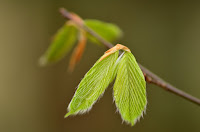




.JPG)
.JPG)
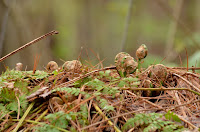
.JPG)
.JPG)
.JPG)
.JPG)
.JPG)
.JPG)
.JPG)
.JPG)
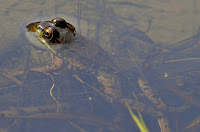
.JPG)

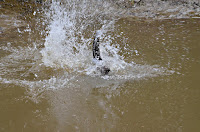
.JPG)
.JPG)


.JPG)

.JPG)
.JPG)
.JPG)
.JPG)
.JPG)
.JPG)
.JPG)
.JPG)
.JPG)





.JPG)
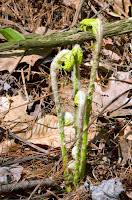
.JPG)



